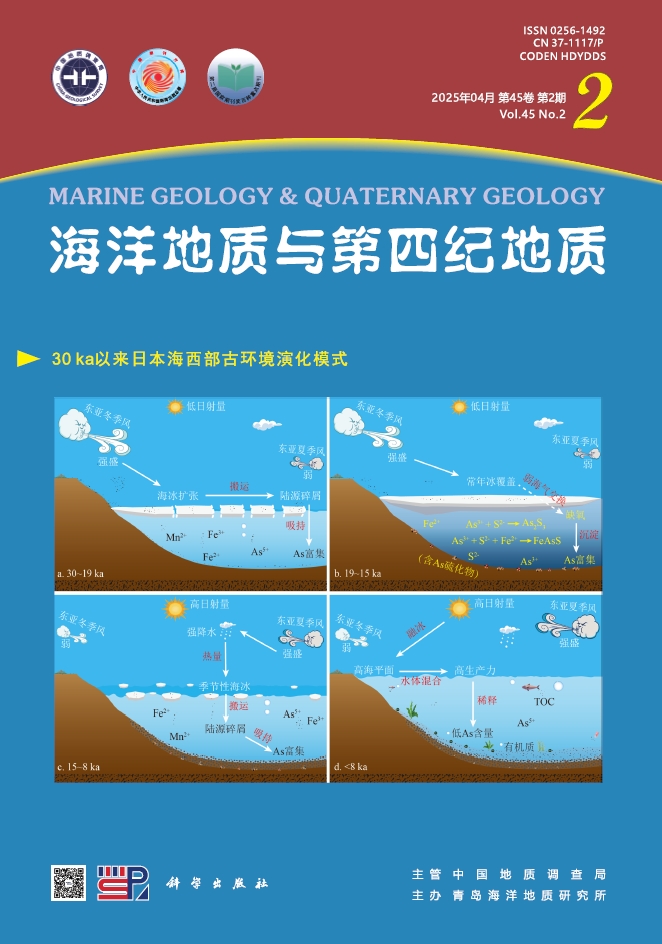| [1] |
张家诚, 林之光. 中国气候[M]. 上海:上海科学技术出版社, 1985.[ZHANG Jia-cheng, LIN Zhi-guang. China Climate[M]. Shanghai:Shanghai Science and Technology Press,1985.]
Google Scholar
|
| [2] |
陈隆勋, 朱乾根, 罗会邦, 等. 东亚季风[M]. 北京:气象出版社, 1991.[CHEN Long-xun, ZHU Qian-gen, LUO Hui-bang, et al. East Asian Monsoon[M]. Beijing:China Meteorological Press,1991.]
Google Scholar
|
| [3] |
Ding Z L, Liu T S, Rutter N W, et al. Ice-volume forcing of East Asian winter monsoon variation in the past 800000 years[J]. Quaternary Research, 1995, 44:149-159.
Google Scholar
|
| [4] |
An Z S, Liu T S, Lu Y C, et al. The long-term paleomonsoon variation recorded by the loess-paleosol sequence in central China[J]. Quaternary International, 1990, 7-8:91-95.
Google Scholar
|
| [5] |
An Z S, Kukla G, Porter S C, et al. Late Quaternary dust flow on the Chinese Loess Plateau[J]. Catena, 1991, 18:125-132.
Google Scholar
|
| [6] |
An Z S, Kukla G, Porter S C, et al. Magnetic susceptibility evidence of monsoon variation on the Loess Plateau of central China during the last 130000 years[J]. Quaternary Research, 1991, 36:29-36.
Google Scholar
|
| [7] |
鹿化煜, 安芷生. 洛川黄土粒度组成的古气候意义[J]. 科学通报, 1997, 42(1):66-69.
Google Scholar
[LU Hua-yu, AN Zhi-sheng. The paleoclimate significance of the Luochuan loess[J]. Chinese Science Bulletin, 1997, 42(1):66-69.]
Google Scholar
|
| [8] |
肖尚斌,李安春,蒋富清, 等. 近2 ka来东海内陆架的泥质沉积记录及其气候意义[J]. 科学通报,2004,49(21):2233-2238.
Google Scholar
[XIAO Shang-bin, LI An-chun, JIANG Fu-qing, et al. The 2 ka record and its climate significance of the mud area of inner shelf of the East China Sea[J]. Chinese Science Bulletin, 2004,49(21):2233-2238.]
Google Scholar
|
| [9] |
肖尚斌,李安春. 东海内陆架泥区沉积物的环境敏感粒度组分[J]. 沉积学报,2005,1:122-129.[XIAO Shang-bin, LI An-chun. A study on environmentally sensitive grain size population in inner shelf of the East China Sea[J]. Acta Sedimentologica Sinica,2005
Google Scholar
,1:122-129.]
Google Scholar
|
| [10] |
Gert J W, Maarten A P. Muddled or mixed? Inferring palaeoclimate from size distributions of deep-sea clastics[J]. Sedimentary Geology, 2003, 162:39-62.
Google Scholar
|
| [11] |
Weltje G J. End-member modeling of compositional data:numerical statistical algorithms for solving the explicit mixing problem[J]. Mathematical Geology, 1997, 29:503-549.
Google Scholar
|
| [12] |
Moreno A, Cacho I, Canals M, et al. Saharan dust transport and high-latitude climate variability:the Alboran Sea record[J]. Quaternary Research, 2002, 58:318-328.
Google Scholar
|
| [13] |
Prins M A, Postma G, Weltje G J. Controls on terrigenous sediment supply to the Arabian Sea during the late Quaternary:the Makran continental slope[J]. Marine Geology, 2000,169:351-371.
Google Scholar
|
| [14] |
Prins M A, Troelstra S R, Kruk R W, et al. The Late Quaternary sedimentary record on Reykjanes Ridge (North Atlantic)[J]. Radiocarbon, 2001, 43(2B):939-947.
Google Scholar
|
| [15] |
Kuijpers A, Troelstra S R, Prins M A, et al. Late Quaternary sedimentary processes and ocean circulation changes at the Southeast Greenland Margin[J]. Marine Geology, 2003,195:109-129.
Google Scholar
|
| [16] |
Jan A V D, Gert J W. Reconstruction of the Late Miocene climate of Spain using rodent palaeocommunity successions:an application of end-member modeling[J]. Palaeogeography, Palaeoclimatology, Palaeoecology, 1999, 151:267-305.
Google Scholar
|
| [17] |
Prins M A, Bouwer L M, Beets C J, et al. Ocean circulation and iceberg discharge in the glacial North Atlantic:inferences from unmixing of sediment distributions[J]. Journal of Geology, 2002, 30:555-558.
Google Scholar
|
| [18] |
Stuut J W, Prins M A, Schneider R R, et al. A 300-ka record of aridity and wind strength in southwestern Africa:inferences from grain-size distributions of sediments on Walvis Ridge, SE Atlantic[J]. Marine Geology, 2002(180):221-233.
Google Scholar
|
| [19] |
秦蕴珊, 赵一阳, 陈丽蓉,等. 东海地质[M].北京:科学出版社, 1987.[QIN Yun-shan, ZHAO Yi-yang, CHEN Li-rong, et al. Geology of East China Sea[M]. Beijing:Science Press,1987.]
Google Scholar
|
| [20] |
胡敦欣,韩舞鹰,章申,等. 长江、珠江口及邻近海域陆海相互作用[M]. 北京:海洋出版社,2001.[HU Dun-xin, HAN Wu-ying, ZHANG Shen, et al. Land-Ocean Interaction in the Estuary of Changjiang River,Zhujiang River and Its Contiguity Sea Area[M]. Beijing:China Ocean Press, 2001.]
Google Scholar
|
| [21] |
海洋图集编委会. 渤海、黄海、东海海洋图集——地质-地球物理[M]. 北京:海洋出版社,1990.[Editorial Board for Marine Atlas. Marine Atlas of Bohai Sea, Yellow Sea and East China Sea Geology and Geophysics[M].Beijing:China Ocean Press, 1990.]
Google Scholar
|
| [22] |
范德江,杨作升,孙效功,等.东海陆架北部长江、黄河沉积物影响范围的定量估算[J]. 青岛海洋大学学报, 2002,32(5):748-756.
Google Scholar
[FAN De-jiang, YANG Zuo-sheng, SUN Xiao-gong,et al. Quantitative evaluation of sediment provenance on the north area of the East China Sea shelf[J]. Journal of Ocean University of Qingdao, 2002,32(5):748-756.]
Google Scholar
|
| [23] |
喻普之,李乃胜.东海地壳热流[M].北京:海洋出版社,1992.[YU Pu-zhi, LI Nai-sheng. Heat flow of East China Sea Crust[M]. Beijing:China Ocean Press, 1992.]
Google Scholar
|
| [24] |
施能,朱乾根. 1873-1995年东亚冬、夏季风强度指数[J]. 气象科技, 2000,3:14-18.[SHI Neng, ZHU Qian-gen. East Asian summer winter monsoon index for 1873
Google Scholar
-1995[J]. Meteorological Science, 2000,3:14-18.]
Google Scholar
|
| [25] |
竺可桢. 中国近五千年来气候变迁的初步研究[J]. 中国科学,1973(2):168-189.[ZHU Ke-zhen. The primary study of the last 5000
Google Scholar
years climate changes in China[J].Science in China, 1973(2):168-189.]
Google Scholar
|
| [26] |
葛全胜,郑景云,满志敏,等. 过去2000 a中国东部冬半年温度变化序列重建及初步分析[J]. 地学前缘,2002, 9(1):169-181.
Google Scholar
[GE Quan-sheng, ZHENG Jing-yun, MAN Zhi-min, et al.Reconstruction and analysis on the series of winter-half-year temperature changes over the past 2000 years in eastern China[J]. Earth Science Frontiers,2002, 9(1):169-181.]
Google Scholar
|






 DownLoad:
DownLoad: